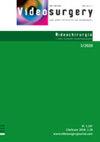Partial cecum resection using endostapler in acute complicated appendicitis with appendiceal base necrosis
IF 1.6
4区 医学
Q2 SURGERY
引用次数: 2
Abstract
Introduction The method of stump closure is controversial in complicated patients, especially with appendix base necrosis or perforation. Aim To evaluate the efficacy and safety of partial cecum resection technique with an endostapler in patients with appendix base necrosis or perforation. Material and methods Thirty-six patients who underwent laparoscopic partial cecum resection due to appendix base necrosis or perforation between 2015 and 2020 were retrospectively analyzed. In acute complicated appendicitis with appendiceal base necrosis or perforation, it was performed by laparoscopic partial cecum resection using an endostapler within a safe surgical margin. Demographic characteristics, duration of operation, days of hospital stay, and intra- and post-operative complications were evaluated. Results The mean age of the patients is 42.72 ±16.69, female/male ratio was 19/17 (52.8%/47.2%). No intraoperative complications developed. Mean operative time and hospital stay were 104.75 ±34.96, 4.58 ±2.82 days, respectively. Post-operative complications developed in 5 (13.7%) patients. One of them was wound infection (2.7%), 2 of them were ileus (5.5%) and 2 patients had an intraabdominal abscess (5.5%). Stapler line leak was not observed in any of the patients. Conclusions The use of an endostapler in laparoscopic appendectomy is a safe and effective technique in cases where appendix base necrosis, appendix perforation or severe inflammation affects the base of the cecum.内镜下盲肠部分切除术治疗急性复杂性阑尾炎阑尾根部坏死
引言残端闭合的方法在复杂的患者中是有争议的,尤其是阑尾根部坏死或穿孔的患者。目的评价内镜下盲肠部分切除术治疗阑尾基底部坏死或穿孔的疗效和安全性。材料与方法回顾性分析2015年至2020年间因阑尾根部坏死或穿孔而接受腹腔镜盲肠部分切除术的36例患者。对于伴有阑尾基部坏死或穿孔的急性复杂阑尾炎,在安全的手术范围内使用内镜下腹腔镜盲肠部分切除术。评估人口统计学特征、手术时间、住院天数以及术中和术后并发症。结果患者平均年龄为42.72±16.69岁,男女比例为19/17(52.8%/47.2%),无术中并发症发生。平均手术时间和住院时间分别为104.75±34.96和4.58±2.82天。5例(13.7%)患者出现术后并发症。其中1例为伤口感染(2.7%),2例为肠梗阻(5.5%),2名患者有腹腔脓肿(5.5%)。任何患者均未观察到缝合线渗漏。结论腹腔镜阑尾切除术中使用内窥镜是一种安全有效的技术,适用于阑尾基底坏死、阑尾穿孔或严重炎症影响盲肠基底的病例。
本文章由计算机程序翻译,如有差异,请以英文原文为准。
求助全文
约1分钟内获得全文
求助全文
来源期刊
CiteScore
2.80
自引率
23.50%
发文量
48
审稿时长
12 weeks
期刊介绍:
Videosurgery and other miniinvasive techniques serves as a forum for exchange of multidisciplinary experiences in fields such as: surgery, gynaecology, urology, gastroenterology, neurosurgery, ENT surgery, cardiac surgery, anaesthesiology and radiology, as well as other branches of medicine dealing with miniinvasive techniques.

 求助内容:
求助内容: 应助结果提醒方式:
应助结果提醒方式:


